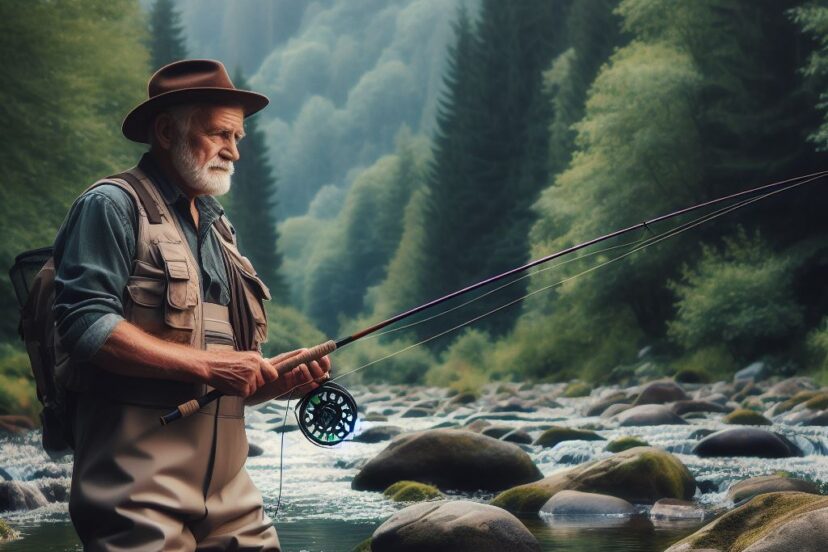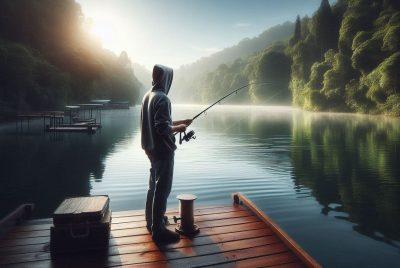What is Fly Fishing: The Art Unveiled
*We may earn a commission for purchases made using our links. Please see our disclosure to learn more.
What is Fly Fishing: Unlocking the Art and Adventure of Angling
Welcome to the enchanting world of fly fishing, where the delicate dance of line and lure transforms fishing into an art form. In this comprehensive guide, we’ll explore the intricate facets of fly fishing, from its historical roots to the nuanced techniques that make it a captivating pursuit. Join me on this journey into the heart of fly fishing, where every cast is a moment of connection with nature.
History of Fly Fishing
Fly fishing traces its roots back to ancient civilizations, with the earliest records dating to the Roman Empire. Macedonian anglers utilized artificial flies to entice fish, setting the stage for a practice that would evolve over the centuries. The 17th-century contributions of English angler Izaak Walton solidified fly fishing as a contemplative and methodical approach to angling. Today, it stands as a blend of tradition and innovation, drawing anglers worldwide to its serene waters.
Essential Fly Fishing Gear
Choosing the Right Fly Fishing Rod
Selecting the ideal fly fishing rod is more than a choice; it’s a personal preference that can significantly impact your angling experience. Dive deep into considerations of rod length, weight, action, and material, allowing you to match your gear to your unique fishing style and the species you target.
Selecting the Ideal Fly Reel
While often overshadowed by the rod, the fly reel plays a pivotal role in your success on the water. Explore the intricacies of drag systems, arbor size, and material, gaining insights into how these components contribute to a reliable and efficient reel.
Understanding Fly Lines and Leaders
The connection between angler and fish lies in the fly line and leader. Explore the critical aspects of weight matching, the role of tapers, and the different types of leaders available. Understanding these elements ensures your presentations are accurate and alluring.
Different Types of Flies and Lures
The world of flies and lures is vast and varied, offering a selection for every angler and scenario. Delve into the characteristics of dry flies, wet flies, nymphs, and streamers, understanding how each entices fish and when to employ them for optimal success.
Fly Fishing Techniques
Casting
Casting is the very essence of fly fishing, where the angler’s skill and precision come to the forefront. Explore the nuances of casting, from the basic overhead cast to advanced techniques like the roll cast, understanding how to adapt your cast to different fishing scenarios.
Presentation
The delicate presentation of the fly is an art that separates successful anglers from the rest. Uncover the secrets of presenting your fly with lifelike movements, mimicking the natural prey and enticing even the most discerning fish.
Retrieval
Mastering the retrieval technique is crucial for a successful catch. Whether you’re employing slow retrieves for dry flies or dynamic stripping for streamers, understanding the nuances of retrieval enhances your chances of fooling the fish.
Reading Water for Successful Fly Fishing
Mastering the art of reading water is paramount for success in fly fishing, and it commences with a keen understanding of fish habitats. Gain insights into identifying prime habitats, ranging from energetic riffles to tranquil pools, as you unravel the diverse environments where fish thrive. Beyond recognizing habitats, delve into the intricate realm of fish feeding patterns. Unlock the secrets that govern their behavior by understanding the influence of factors such as water temperature, light conditions, and the presence of insects.
This knowledge serves as a compass for anglers, guiding them to strategic locations and allowing a more nuanced approach to presenting flies that mimics the natural prey of fish. As you embark on your fly fishing journey, the ability to read water becomes a vital skill, transforming each casting moment into a calculated dance with the elusive and captivating world beneath the surface.
Best Fly Fishing Locations

Embark on a fly fishing odyssey by exploring the best locations, each offering its unique allure. Rivers and streams, with their rhythmic flow, provide a captivating backdrop for anglers seeking the thrill of moving waters. Navigate the challenges and savor the rewards, whether delicately presenting flies in small streams or conquering the vastness of large rivers. Transition to the tranquility of lakes and ponds, where still waters present a different set of challenges and opportunities. Delve into strategic approaches, from understanding the thermocline to selecting the perfect fly for sedentary trout or bass.
The adventure doesn’t stop there; venture into the thrilling realm of saltwater fly fishing. From the shallow flats to the deep blue expanses, discover the diversity of saltwater environments teeming with unique species that await the fly angler’s expertise. Each location unfolds as a chapter in the angler’s story, promising new challenges, experiences, and the enduring magic of fishing.
Seasons and Fly Selection
Embark on a seasonal journey in the world of fly fishing, where the ever-changing tapestry of nature dictates angling strategies. As seasons shift, witness the emergence of various insect hatches influencing the feeding behavior of fish. Master the art of matching the hatch, a skill crucial for success, by selecting the right fly that mirrors the prevalent insects, heightening the likelihood of a fruitful catch.
Dive deeper into the intricacies with effective patterns tailored for each season. Experience the lively emergence of spring, the serene days of summer, and the challenging conditions of fall and winter. Adapt your techniques and fly selection harmoniously, aligning them with the unique demands of each season. In this cyclical dance with nature, fly fishing becomes not just a sport but a dynamic and ever-evolving pursuit that rewards adaptability and an intimate understanding of the natural rhythms that govern the waters.
Fly Fishing Etiquette
In the realm of fly fishing, etiquette extends beyond personal pursuits, emphasizing the communal nature of the sport. The unspoken principles of respect for fellow anglers create a harmonious environment on the water, enriching the shared experience. Equally vital is the embrace of catch and release practices, marking an angler’s commitment to responsible stewardship.
Delve into the ecological benefits, master proper handling techniques, and actively contribute to the conservation of fish populations. In the world of fishing, these principles not only elevate individual experiences but collectively contribute to the preservation of our aquatic ecosystems.
Troubleshooting Common Fly Fishing Issues
Navigating the waters of fly fishing involves confronting common challenges head-on. With wind also presenting itself as both an ally and adversary. In the face of gusts and breezes, learn invaluable strategies to overcome wind challenges, ensuring accuracy in your casts and adeptly adjusting your casting technique to accommodate fluctuating wind conditions. Additionally, the journey is not without its share of snags and tangles, integral aspects of the angling experience.
Arm yourself with practical troubleshooting tips, allowing you to gracefully navigate through these obstacles without compromising your composure or forfeiting valuable fishing time. In the dynamic world of fishing, mastering these troubleshooting skills enhances your resilience on the water, transforming obstacles into opportunities for growth and skill refinement.
The Joy of Catch and Release
Embark on a journey into the profound joy of catch and release. Uncover its far-reaching positive impact on both fisheries and ecosystems. Delve into the scientific underpinnings of responsible angling, gaining insights into the crucial role anglers play in preserving the delicate balance of aquatic environments. Responsible angling extends into a broader mindset. Also encouraging ethical fishing practices and a commitment to minimizing one’s environmental footprint.
By adopting this conscientious approach, anglers become stewards of the water, actively contributing to the enduring health and sustainability of fisheries. In embracing responsible angling, the joy of catching and releasing transforms into a meaningful connection with the natural world, fostering a legacy of environmental conservation for future generations of anglers to come.
Conclusion
In conclusion, fly fishing is not just a pursuit; it’s a captivating journey that transcends the ordinary. As we’ve navigated the intricacies of fly fishing, from its historical tapestry to the nuanced techniques that define success, one thing remains abundantly clear: it’s more than the act of catching fish. Fly fishing is a lifelong exploration of nature’s beauty, an artful dance of skill and patience.
Whether you’re casting your first line or have weathered the challenges of countless fishing trips, the world of fly fishing invites us to connect with the essence of the outdoors. Each ripple on the water, every graceful cast, and the stories etched in memory contribute to a tapestry of experiences that make fishing a truly enriching and enduring endeavor.
FAQs about Fly Fishing
- Q: Is fly fishing suitable for beginners?
- A: Indeed, fly fishing is accessible to beginners, offering a rewarding and enjoyable experience. Patience and practice are key to mastering the art.
- Q: What’s the best time of year for fly fishing?
- A: The ideal time varies, but generally, spring and fall are considered prime seasons. Each season presents unique opportunities and challenges.
- Q: How do I choose the right fly for a specific fish species?
- A: Consider factors like natural prey and water conditions. Also the fish’s behavior to select the most effective fly pattern for your target species.
- Q: Is catch and release necessary in fly fishing?
- A: While not mandatory, catch and release practices contribute to conservation efforts, ensuring sustainable fish populations for future generations.
- Q: Can I fly fish in saltwater?
- A: Absolutely! Saltwater fly fishing opens up exciting possibilities, from chasing bonefish on flats to battling powerful tarpon offshore. The adventure extends beyond freshwater realms.




